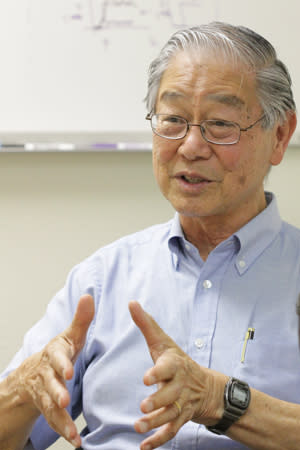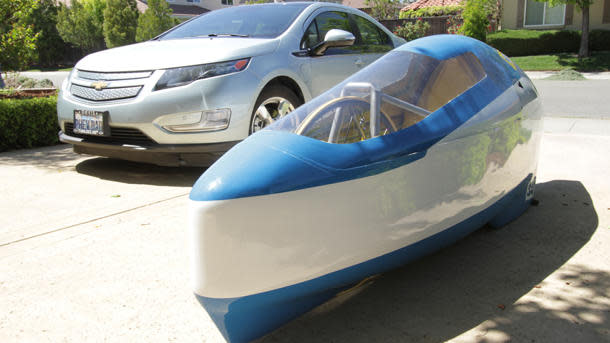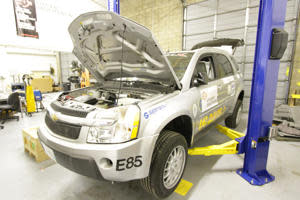 Motoramic
MotoramicHow the father of plug-in hybrids still has a race to finish
For more than 25 years, engineering students at the University of California-Davis have sought ways to make the world burn less oil on "Team Fate," a name borrowed from the film "The Great Race," where Jack Lemmon's Professor Fate never faltered in his goal of winning a New York-to-Paris contest. It's one of several honors for Andy Frank, a real-life Professor Fate whose ideas have made him the father of plug-in hybrids, a technology he's still racing hard against fate.
Raised in Pasadena hot-rodding everything from Chevys to Porsches, Frank helped design supersonic aircraft and missile-guidance systems during the Cold War and had a hand in landing men on the moon for NASA. This is not your average eco-machine warrior.
"To truly change the world, we have to do it so everybody wins, including the oil companies," says Frank, 78, a soft-spoken mechanical and aeronautical engineer whose office wall features his patent for driving a car off a combination of engines and batteries.
"The all-electric car is still 40 or 50 years ahead of its time, because we don't have the infrastructure to support it yet," he says. "But by using electricity as well as gas, though just less of it, we can go a long way to solving our problems."

"Most people don't think past tomorrow. You have to have a longer view of the world."
No one was paying attention when Frank first found his message. Automobiles on the road when he began his work wasted 80% of the energy they carried in their tanks. Through the morass of possible solutions, Frank came to believe the best alternative was to recapture energy by using the car's own motion to charge batteries, or add to what the car already carried through an electrical outlet. Today, most major automakers around the world have some kind of hybrid system in production or their labs that draw from Frank's ideas -- and in several cases, built by the engineers he trained.
Although well beyond retirement age, Frank comes to work daily at a nondescript warehouse just south of Davis. It's the headquarters of Efficient Drivetrains Inc., and today Frank and a few students are running diagnostic tests on a massive flywheel system destined for a delivery truck.
Many of Frank's clients today hail from China, where Frank emigrated from as a child at the dawn of World War II. China, he says, wants alternatives to fossil fuels badly as it becomes the world's largest market for new vehicles; just recently, the China State Council announced it wanted 500,000 plug-in and electric vehicles on the roads by 2015, and some 5 million by 2020.
It's less about the environment, but rather an "acknowledgement that global fuel reserves are dwindling and prices are going up, so they want cars that aren't going to rely as heavily on gas," Frank says.
Among the many fuel-sipping hybrids he's built since landing at Davis 25 years ago, none tops a one-man, bullet-shaped, bicycle-tired contraption constructed in 1989. The idea was to see how many miles could be traveled on one gallon of gas. "People were shooting for 300 miles, but we hit 3,300," he says, a proud smile creasing his face.
During the Clinton-Gore years, the profile of fuel efficiency rose. Frank made a 68-mpg hybrid Ford Taurus in 1995, and helped General Motors convert its EV1 into an 85-mpg hybrid.
He says improvements in efficiency will come with strides in technology, particularly in battery capability and cost. But changes in attitudes toward green machines are perhaps another matter.
"I know there is often a lot of anger on the topic, and it doesn't surprise me," he says. "There are elements of nationalism involved, like 'I like my big cars and guns' sort of thing. Most people don't think past tomorrow. You have to have a longer view of the world."
Frank has quietly espoused that altruistic mentality over the decades, and it's not surprising that it rubbed off on some students. One is Ming Kuang, who found a mentor in Frank at Davis. Today, Kuang is key member of Ford's Electrification Research and Advanced Engineering unit, charged with helping the automaker both improve fuel efficiency and push forward with new hybrids, such as the upcoming Fusion Hybrid and C-Max.
"Without professor Frank, I simply wouldn't be doing what I'm doing," says Kuang. "He's not just a visionary, but he's a real straight shooter who is guided by data. Through him, I realized that by going into the automotive industry I could do something not just for the environment but also for the future of my children."
What's missing from any conversation with Frank is a diatribe on global warming. Whatever the engineer may think about the topic, he keeps to himself. Instead, he recalls the first time he felt motivated to eek more miles out of the 1936 Ford he had in the early 1950s.
"Gas might have been cheap back then, but it wasn't if you didn't have any money, and we were poor folk," he says with a laugh. "That's when I thought, why can't you go farther than a few miles on a gallon of gas? So I started tinkering with that. And believe me, nobody cared."
Frank almost brought that mentality to Detroit in the mid-1950s. But when Northrop Grumman offered him more money, he disappeared into the world of supersonic spy planes and multi-warhead missiles, which then led to work on Apollo projects such as the lunar space module. In the late '60s, Frank decamped for the University of Wisconsin-Madison, where he kicked off his enduring work on drivetrains.
"Along the way, there have been many lessons learned. For the most part we had good ideas but the technology just wasn't there yet," says Frank, referencing early battery technology that came straight from aerospace and proved far too costly for commercial use. "Eventually, we came to see that hybridization, using two energy sources, was the way to go. And that's where we still are. It's just getting easier to do it."
So the obvious question remains. What does Frank drive? Perhaps not surprisingly, it's a Chevy Volt, plugged via a long extension cord into a simple 110-volt outlet in his spartan office. The license plate: PHEV DAD. Not that the patriarch of plug-in electric vehicle technology doesn't still have a piece of that Pasadena hot-rodding kid inside.
"I'm working on some tweaks," he says, a mischievous smile. "I like to burn rubber."

 Yahoo Autos
Yahoo Autos 

